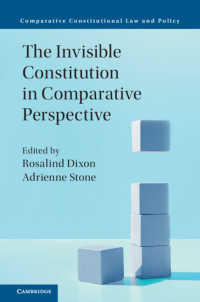Full Description
These interdisciplinary studies address pre-1900 non-Western urban growth in the African Sudan, Mexico, the Ottoman Middle East, and South, Southeast, and East Asia. Therein, primary and secondary cities served as functional societal agents that were viable and potentially powerful alternatives to the diversity of kinship-based local or regional networks, the societal delegated spaces in which local and external agencies met and interacted in a wide variety of political, economic, spiritual, and military forms. They were variously transportation centers, sites of a central temples, court and secular administration centers, fortified military compounds, intellectual (literary) activity cores, and marketplace and/or craft production sites. One element of these urban centers' existence might have been more important than others, as a political capital, a cultural capital, or an economic capital. In the post-1500 era of increasing globalization, especially with the introduction of new technologies of transport, communication, and warfare, non-Western cities even more became the hubs of knowledge, societal, and cultural formation and exchange because of the location of both markets and political centers in urban areas. New forms of professionalism, militarization, and secular bureaucratization were foundational to centralizing state hierarchies that could exert more control over their networked segments. This book's authors consciously attempt to balance the histories of functional urban agency between the local and the exogenous, giving weight to local activities, events, beliefs, institutions, communities, individuals, and historical narratives. In several studies, both external and internal societal prejudices and the inability of key decision makers to understand indigenous reality led to negative consequences both in the local environment and in the global arena.
Contents
Chapter 1 Introduction
Chapter 2 Chapter 1: Cities, Networks, and Cultures of Knowledge: A Global Overview
Part 3 Part I: Urban Networking in the Early Indian Ocean Realm
Chapter 4 Chapter 2: Port-City Networking in the Indian Ocean Commercial System Represented in Geographic and Cartographic Works in China and the Islamic West from c. 750 to 1500
Chapter 5 Chapter 3: Secondary Ports and Their Cults: Religious Innovation in the Port System of Greater Quangzhou (Southern China) in the 10th-12th Centuries
Chapter 6 Chapter 4: Buddhist Conversions and the Creation of Urban Hierarchies in Vietnam and Cambodia, c. 1000-1200
Chapter 7 Chapter 5: Why Did Le Van Thinh Revolt? Buddhism and Political Integration in Early 12th Century Dai Viet
Chapter 8 Chapter 6: Khuba and Muslim Networks in the Indian Ocean (Part II) — Timurid and Ottoman Engagements
Chapter 9 Chapter 7: Urbanization and Ironworking in the Nubian State Tradition
Part 10 Part II: Secondary Cities and Urban Networking in the Non-Western World, c. 1500-1900
Chapter 11 Chapter 8: Dengzhou and the Bohai Gulf in Seventeenth-Century Northeast Asia
Chapter 12 Chapter 9: The Origins of the Post Designation System in the Qing Field Administration Network
Chapter 13 Chapter 10: The Collapse of the English Trade Entrepôts at Pulo Condore and Banjarmasin and the Legacy of Early British East India Company Urban Network-Building in Southeast Asia
Chapter 14 Chapter 11: Taverns and Their Influence on the Suburban Culture of Late Nineteenth-Century Mexico City
Chapter 15 Chapter 12: Networks, Railroads, and Small Cities in the Ottoman Balkans
-

- 洋書電子書籍
-
憲法の不可視性:比較考察
The…
-

- 洋書電子書籍
- Anatomy of a Lawsui…





